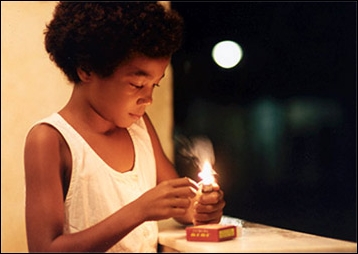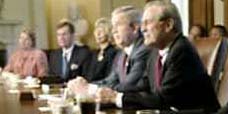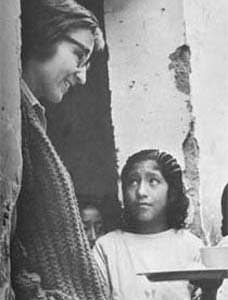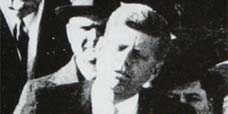
Saint Lucia RPCV David Whitman is a professional photographer, art director and graphic artist, recognized with a National Geographic Traveler international photography award in 1994
Carnaval Musings:
"Yellow" Brazil...
by David Whitman Week of Feb 5 - 11, 2004
Caption: If Rio is blue, then yellow is the color of Brazil. It is everywhere, announcing itself radiantly and unselfconsciously. Luscious yellow fruits, flamboyant yellow feathers, ubiquitous yellow soccer jerseys. Flowering trees, wooden boats, beach umbrellas, passion fruit, gold, parrots, buildings, swimsuits, license plates. The word in Portuguese, amarelo, even contains the verb amar, “to love, to adore.”
David Whitman is a professional photographer, art director and graphic artist, recognized with a National Geographic Traveler international photography award in 1994. His work has been on exhibit in California (1988-98); Bahia, Brazil (1997-98); and Miami (2002-03). One of his photos taken in Bahia was selected for the cover of the 2005 Returned Peace Corps Volunteers’ International Calendar. A writer, editor, and artists’ representative, he is also an education outreach coordinator at the Fairchild Tropical Botanic Garden, in Coral Gables, where he works primarily with environmental education programs for South Florida teenagers. He was the founding executive director of the Miami Beach Cultural Arts Council, an eleven member civic board he directed for four years, whose mission was to support excellence in artistic expression through grants, advocacy, facilities, development, and cultural tourism and marketing initiatives. He created the ArtsBeach campaign to promote Miami Beach globally as a preeminent cultural destination, directed the Miami Beach Arts Trust, a not-for-profit fund-raising corporation that supports the arts, and was a member of the cultural delegation to Brazil led by Florida’s Secretary of State in 2000. For fourteen years, he managed the University of California at Berkeley’s Hertz Concert Hall, where he received the university’s Outstanding Achievement Award and, twice, its highest staff honor, the Distinguished Achievement Award. He holds a degree in Forestry from the University of California, with additional academic work at the U.S. Institute of Tropical Forestry in Puerto Rico. He was also a Peace Corps volunteer in Saint Lucia (1978-81) and an American Field Service exchange student in Belgium (1972-73).
Editor’s note: with most Brazilians absorbed by the annual Carnaval celebrations, we at InfoBrazil decided to break away for a bit from the usual political, business and economic content, and asked the author, an accomplished photographer, to reflect on his time spent in Brazil.
The idea that a place could be identified with just one color came to me while reading the impressions of someone spinning around high on a hill overlooking Rio de Janeiro, taking in the dizzying images of sky, bay, buildings. The author described her sudden realization that Rio is a “blue” city. I intuitively understood what she meant, for I often see the world in the colors of an artist’s palette.
If Rio is blue, then yellow is the color of Brazil. It is everywhere, announcing itself radiantly and unselfconsciously. Luscious yellow fruits, flamboyant yellow feathers, ubiquitous yellow soccer jerseys. Flowering trees, wooden boats, beach umbrellas, passion fruit, gold, parrots, buildings, swimsuits, license plates. The word in Portuguese, amarelo, even contains the verb amar, “to love, to adore.”
The color yellow flows through Brazil like the Amazon. Even in the countless shades of green, there is always underlying yellow, kissed by blue. Yellow transforms red too, into rich orange earth and fiery solar reflections of the equatorial sun rising from the sea. And in the stunning diversity of Brazil's people, irises from pale green to amber to darkest brown are all tinted by yellow.
Surrounded by luminescent blues and greens, yellow is the reigning color of Carnival. From Rio’s Sambódromo to São Luís do Maranhão and beyond, glorious, exuberant, pulsating yellow announces Brazil to the world. It radiates confidence, attracts attention, seduces. Yellow in Brazil has no close rival.
In contrast, yellow is elusive in the photos I’ve taken in my native California. A decade ago, this realization made me contemplate other visual characteristics of Brazil. I decided to photograph “Brazilianness”: the tropical colors, the gestures, the unposed stances on the street and beach that reveal the essence of the country.
I noticed that many Brazilians – especially at the beach – stand with a thumb casually hooked onto their hip. Suddenly it seemed that everyone, wherever I went and no matter what age, was standing just that way. Then traffic patterns caught my eye. I observed that pedestrians in Rio didn’t abide by any right-of-way rules, even on the narrow streets of the historic city center.
Instead of staying to the right, as is common in many other places, residents followed no discernible patterns as they made their way through the crowded streets. This was especially evident when hundreds would be waiting to cross a busy intersection, to then converge onto the streets in seeming chaos. I pointed this out to a longtime Rio resident, who looked surprised at my observation, then declared, "É verdade…a gente ziguezague!" or, it’s true…we zigzag!
Suddenly, everywhere, I started to notice zigzagging Brazilians wearing yellow. The more I tried to disprove my latest indicator of Brazilianness, the more I’d encounter it. Walking up to a juice stand, for instance, I’d see that nearly all the fruits would be yellow, and the customers would be standing in that characteristic way with a thumb hooked, most of them wearing yellow. Often the walls would be painted yellow; the signs and tabletops too. And everywhere, the Brazilian flag with its central yellow diamond.
Brazil has given me a profound appreciation of yellow, and I’ve surrounded myself with the color here in Miami. Accent walls in my beach studio are yellow, and outside are yellow and green coconut palms. Yellow transforms the ocean surf to Caribbean turquoise and sea-green. Even my car, the “mangomobile,” is yellow. Nearly every morning at the tropical botanic garden where I work, I see the sunlit, brilliant yellow and contrasting blue feathers of wild macaws flying overhead, and recall Brazil.
It’s the color of joy, yellow…and the color of my Brazil.
Samples of David Whitman’s photography










